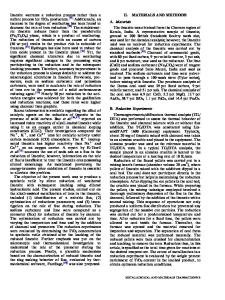Phase Evolution During the Carbothermic Reduction Process of Ilmenite Concentrate
- PDF / 2,109,047 Bytes
- 9 Pages / 593.972 x 792 pts Page_size
- 55 Downloads / 348 Views
N
VANADIUM -titanium-bearing magnetite of Panzhihua, China, is a complex iron ore which is rich in the elements of vanadium and titanium. It accounts for more than 90 pct of the titanium reserves in China. By the beneficiation process of the ore, titanomagnetite concentrate and ilmenite concentrate are produced.[1,2] At present, three hundred thousand tons of ilmenite concentrate are produced every year. However, it has a dense structure and a high content of impurities, especially magnesium oxide. For this reason, Panzhihua ilmenite is not suitable for the chlorination process to produce TiO2 pigment. The sulfate process is usually used to manufacture TiO2 pigment from Panzhihua ilmenite. The dilute spent acid formed during hydrolysis is not presently recycled to the process, which causes not only environmental problems but also waste of sulfur resource.[3] There is no appropriate and economic method to deal with the ilmenite concentrate. Considering the factor of environment and economy, the preparation of TiC and TiN by the ilmenite concentrate has been receiving more and more attention.[4,5] In this process, the research on the reduction mechanism is crucial. Over the past decades, many works have been conducted on the mechanism and kinetics of the carbothermic reduction of ilmenite.[6–13] Welham and Willis[4] studied the weight change of the sample with the HAI-PENG GOU, Doctoral Student, GUO-HUA ZHANG, Associate Professor, KUO-CHIH CHOU, Professor, are with the State Key Laboratory of Advanced Metallurgy, University of Science and Technology Beijing, Beijing, P.R. China, and also with the School of Metallurgical and Ecological Engineering, University of Science and Technology Beijing, Beijing, P.R. China. Contact e-mail: ghzhang_ustb @163.com Manuscript submitted April 9, 2014. Article published online September 16, 2014. 48—VOLUME 46B, FEBRUARY 2015
heating rate of 20 K/min (20 °C/min) under argon atmosphere. The sample was ball milled for 100 hours to homogenize the material and the molar ratio of ilmenite to graphite was 1:4. They also studied the samples annealed isothermally for 1 hour under argon and nitrogen. Coley et al.[6] used one gram ilmenite pellet and 1.77 times of the stoichiometric requirement of ‘‘Collie’’ coal at temperatures range of 1587 K to 1790 K (1314 °C to 1517 °C) under argon atmosphere to generate carbon-saturated iron and titanium oxycarbide. Gupta et al.[7,10] investigated the reduction of synthetic ilmenite and three kinds of ilmenite concentrates using coal at the temperature range of 1273 K to 1373 K (1000 °C to 1100 °C) under argon atmosphere. The concentrate-coal mixture was adjusted such that the molar ratio of carbon to oxygen (C/O2) was 2, which corresponds to the maximum carbon requirement for the removal of all the oxygen in the ilmenite sample as carbon monoxide. The reaction rate was found to increase significantly by the addition of ferric chloride which promoted the nucleation of iron, while the rate was decreased by the addition of rutile and manganese which stabilize
Data Loading...











